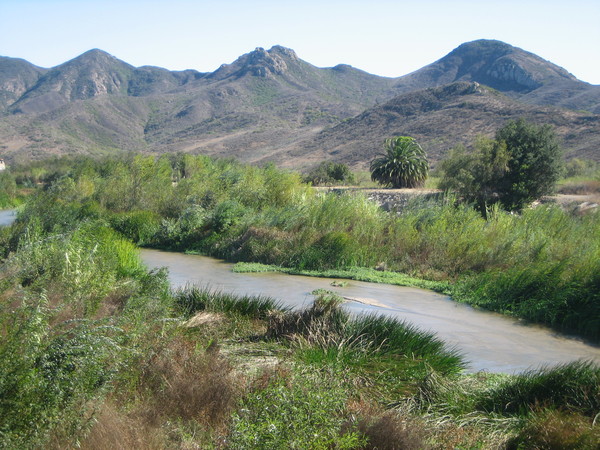The ESRM Program
The Environmental Science and Resource Management (ESRM) Program houses applied ecology, field science, coastal science, geomorphology, geospatial science, and interdisciplinary natural resource management efforts here at CSU Channel Islands. The ESRM Program has a strong focus on both the wildland-urban interface and the coastal zone, drawing heavily upon these interface zones for both scholarship and educational orientation. Our program places the utmost importance on exceptional undergraduate teaching. The ESRM Major has a strong interdisciplinary curriculum emphasizing ecological restoration, GIS, land use, field methods, conservation mechatronics/robotics, human dimensions of resource management, and conservation biology after two years of basic coursework in biology, chemistry, physics, political science, and economics. Many of our courses stress technical writing and communication, undergraduate research, and service learning. All our students complete a mandatory year-long research project prior to graduation.
While our program is small, faculty and student research teams nevertheless work on a variety of projects in a variety of systems including riparian and wetland restoration, rapid ecological assessments, habitat fragmentation, hydrogeomorphology, fire ecology, avian ecology, coastal fisheries, coastal geomorphology, engaging underserved populations with protected areas, water quality, ecotoxicology, seafood sustainability, public perceptions of coastal resources, sea level rise adaptation, and management of sandy beaches. Our nascent Unmanned Aerial System (aka drone) and Remotely Operated Vehicle (ROVs) capability is growing rapidly and will expand across both our scholarship and teaching in the coming years. Our teaching, research, and service tends to focus on our local (southern California) coastal zone with particular emphases on the Santa Monica Mountains (where our main campus resides), the California coast from Los Angeles to Santa Barbara, and Santa Rosa Island (home to our field station). Keeping with our university’s international emphasis, ESRM faculty also conduct research and teach courses in systems outside of California such as New Orleans, coastal Louisiana, Costa Rica, Hawai’i, the Cook Islands, and Turkey. We are currently developing a Professional Science Master’s Program, expected to begin in the next two years. Our Sierra Hall HQ opened in September 2015) and houses our new computer lab, research spaces, and classrooms.
CSU Channel Islands
CSU Channel Islands is the newest addition to the 23-campus California State University System, the largest public university system in the United States with a half million students. Our campus formally opened in 2002, registering our first freshman class in 2004. Our 1,193 acre main campus in Camarillo, California is home to (as of Fall 2015) approximately 6,000 undergraduate and 250 graduate students with enrollment slated to more than double at full campus build-out. Additional facilities include our recently-opened Santa Rosa Island Research Station, Channel Islands Harbor Boating Center, and satellite campuses in Thousand Oaks, Santa Barbara, and Goleta. Placing students at the center of the educational experience, CSU Channel Islands provides undergraduate and graduate education that facilitates learning within and across disciplines through integrative approaches, emphasizes experiential and service learning, and graduates students with multicultural and international perspectives.
We are proud of our commitment educate students historically underserved in higher education. CSU Channel Islands is a federally designated Hispanic Serving Institution, ranked 19th on the most recent “Top 50 Colleges for Hispanic Students” list. More than 51% of our students come from traditionally underrepresented minority groups, 65% are women, 54% first generation college goers, and 52% eligible for Pell Grants (a proxy for low-income). Our innovative, award-winning Veterans Resource Center has been key to making our campus more welcoming to our active duty and former military students.
CSU Channel Islands has been named a “Great College to Work For” by the Chronicle of Higher Education four of the past six years, ranks 46th on the Sierra Club’s “Cool Schools” list, has been an Arbor Day Foundation “Tree Campus USA” for the past four years, is a Princeton Review Green College,” and been placed on President Obama’s Higher Education Community Service Honor Roll for the fifth straight year.
Research & Teaching Facilities

Tech Lab
robotics, environmental sensors, & 3D printing

ConsBio Lab
teaching space & dissection/microscopy

Prep Lab
administrative & logistics HQ for field work

GIS Lab
GIS, LIDAR, & large data set processing

Modoc Lab
our “dirty” lab for sediments & wet sample processing

Greenhouse
home to our seed bank & germination efforts

CamPark
370 ac outdoor riparian corridor/restoration lab

Hay Barn
pseudo “indoor” space for drone flight training

SRI Research Station
our field station on
Santa Rosa Island

Long Grade Creek
main campus’ 3 ac seasonal creek/restoration lab

Boating Center
Channel Islands Harbor docks, boat yard, & classrooms

Manzanita Wash
equipment rinse/wash & 500 gallon ROV test tank

Manzanita Cage
field equipment storage

Makerspace
general access drone & electronics building space

Manzanita Archive
sample & record archive

Sustainability Lab
model building for testing lighting, windows, etc.

FIT Studio
teaching innovation lab & collaboration space

Herbarium
small, but growing mainland & island plant archive
Past Pirates Cogitate
We are always looking to add to our Pirate crew as we always seem to have 3 more things to do than we can seem to get to by our deadline. If you are the responsible, hard-working type willing to put the time in to learn some new skills and help our planet, we'd love to have you.
But lest you take my word for it, here are some unrehearsed reflections from previous Pirates.


